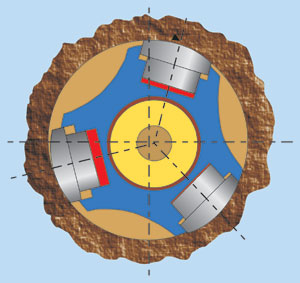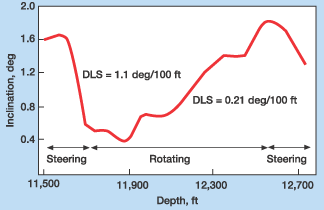New drilling technology improves ROP and lowers drilling costs
DRILLINGNew drilling technology improves ROP and lowers drilling costsHow a closed-loop steering system enabled near-zero degree vertical drilling through deepwater salt sections and faulted zones, saving money through higher penetration rates while reducing casing / drill-pipe wearNigel Evans, Baker Hughes INTEQ, Houston
Conventional Systems While the industry has invested heavily in developing horizontal drilling, there has not been much effort toward improving methods for drilling tight-tolerance vertical wells. Conventional approaches for maintaining verticality while drilling salt, dipped or faulted formations include pendulum-drilling assemblies, packed-hole drilling assemblies and MWD measurements to control a steerable motor. In extreme cases, operators have been forced to employ openhole whipstocks or sidetracks to maintain a vertical wellbore. Unfortunately, each of these approaches has drawbacks that can increase drilling time. Pendulum drilling assemblies. When drilling with a pendulum assembly, a stabilizer is placed 30 to 60 ft above the drillbit. While this approach delivers a more vertical wellbore, it also restricts the amount of weight on bit, which in turn limits ROP. Packed-hole drilling assemblies. The large, near-bit stabilizer and additional uphole stabilizers found in packed-hole assemblies often increase torque and drag. In extreme cases, this leads to differential sticking and/or drillstring failure (i.e., twist-off). MWD/steerable motor. While it is possible to use MWD and a steerable motor to "knock" the angle back toward vertical by re-orienting to the low side, it is often mathematically difficult to differentiate between high and low sides at a small inclination. This approach also creates ledges, is time-consuming, costly and associated with low WOB. Closed-Loop System The new, proprietary VertiTrak straight-hole drilling device from Baker Hughes INTEQ performs closed-loop steering using downhole inclination sensors and expandable stabilizer pads designed to counteract a formation’s natural buildup tendency. The system combines a steering unit, a high-performance motor section and near-bit MWD inclination sensors that sense deviations as small as 0.1° from vertical, Fig. 1.
Using measured data, internal microprocessors calculate the force required to overcome the deviation from vertical. In response, hydraulic lines deliver pressure to each of the three expandable steering pads, thus steering the well back to vertical. The high-thrust (up to 3 t/rib), spring-loaded pads deliver continual course control that is independent of drilling parameters and formation tendencies, Fig. 2. Consequently, the system reduces wellbore tortuosity while eliminating unplanned doglegs and ledges for a more uniform-gauge borehole – making it easier to run casing and reducing casing wear when drilling subsequent sections. In addition, the system’s integral mud pulser transmits inclination and tool status information.
Unlike the company’s AutoTrak rotary closed-loop drilling system, the steering ribs are an integral part of the downhole motor and are mounted on a non-rotating sleeve. Thus, the system can only steer when there is no drillstring rotation. However, the tool’s steering function can be switched off by sending a downlink, which allows the tool to be used with or without drillstring rotation. This capability permits operators to keep inclination within a small window by switching between steering / slide-drilling and rotary mode, especially when a higher ROP is more important than a perfectly vertical well. Worldwide Applications An early version of this system was first deployed in 1990 on the KTB Ultra Deep Scientific Wellbore. This system was used in 100 runs down to 23,600 ft while maintaining a straight, vertical borehole. In 1996, tool improvements were jointly developed with Eni-Agip, which wanted to drill formations with high dip angles of 30° to 60° in the Mediterranean region. These formations tend to deviate the well from vertical when drilling with conventional pendulum BHAs. The system enabled Eni-Agip to drill cluster wells using a lean profile (slim-casing concept). In addition to its use in Italy, the system has proven effective at drilling vertical wells in South America and through the Gulf of Mexico’s deepwater salt formations. Basilicata, Italy. When attempting to drill the Monte Grosso-1 well, Eni-Agip encountered formations in a 17-1/2-in.-dia. dolomite section that resulted in excessive deviation from vertical. The resulting tortuosity led to high torque conditions which, in turn, compromised drill-pipe integrity and resulted in a twist-off. Following unsuccessful fishing, over 6,500 ft of hole was lost and cemented. The drilling team decided to initiate a sidetrack and hole-straightening operation using a 16-in. version of the new drilling system. This was the first application of its kind anywhere in the world. The system sidetracked the well from 5.2° to vertical within 500 ft, at a drop-off rate ranging between 0.8° and 1.5° per 100 ft. A full sidetrack was achieved within 80 ft of the cement plug using an HC-MAXGT18D tricone bit. Consequently, Agip completed the 16-in. section and recovered the well from a total loss situation. On direct comparison with the original 17-1/2-in. section, the closed loop approach reduced overall re-drill time on the 16-in. section by 19 days – saving the operator in excess of $900,000. South America. In this example, the operator had encountered multiple problems maintaining a vertical wellbore while drilling in the Andes Mountains. In these highly dipped and faulted diamictite and shale formations, conventional drilling methods experienced significant delays while attempting to steer the wellpath back to vertical. It was decided that running the new vertical closed-loop drilling system – with a downhole thruster to deliver constant WOB – would deliver improved vibration control. The system maintained a vertical wellbore without compromising key drilling parameters such as WOB and optimized bit selection. ROP was improved 200% to 300% in the 16-in. hole section, which was drilled using PDC bits. The well reached TD in 28 fewer days than the best offset drilled using a more conventional approach. No backreaming was required, and the vertical wellbore facilitated smooth casing runs and delivered significant savings in subsequent hole operations. Mississippi Canyon, Gulf of Mexico. For a 14-3/4-in. well in the Mississippi Canyon area, Chevron was experiencing difficulty in drilling truly vertical wells through a deepwater salt formation, between 11,500 ft and 12,700 ft. The well was being drilled from a platform in 4,650-ft water. Due to deviation tendencies that are common with PDC bits when drilling through salt, traditional drilling systems required restricted penetration rates in an attempt to maintain a vertical wellbore. In addition, the well had experienced BHA and string failures while drilling with conventional systems. After switching to the new system, Chevron was able to drill a high-quality wellbore while maintaining verticality through the salt section. Near-bit sensors monitored and pulsed inclination data to the surface. Between intermittent course corrections, the steering pads were disengaged to permit rotary drilling at a high ROP. Whenever hole inclination exceeded acceptable limits, the steering pads were re-engaged to steer the wellpath back to vertical while sliding. Switching between the system’s two drilling modes enabled Chevron to achieve high penetration rates in both rotating (137 ft/hr) and steering (90 ft/hr) modes – a record for this area of the GOM, Fig. 3.
Conclusion The VertiTrak system’s closed-loop drilling
approach has helped operators drill true vertical wells in some of the world’s most challenging drilling
environments, including deepwater salt intervals, faulted zones and rugged, orogenic-related formations.
Consequently, operators have been able to obtain high quality, vertical wellbores while maintaining optimal
drilling parameters (i.e., WOB, bit selection, etc.). In addition, the system has proven successful at
delivering lean casing profiles, reducing gross measured depths and lowering overall drilling costs.
Acknowledgment The author thanks Baker Hughes INTEQ for its permission to publish this paper, as well as Agip and Chevron for use of their application descriptions. Special thanks to Ray Newton and Kendall Manning for their review and comments, and Oscar Sajche for his artistic contributions.
|
||||||||||||||||






